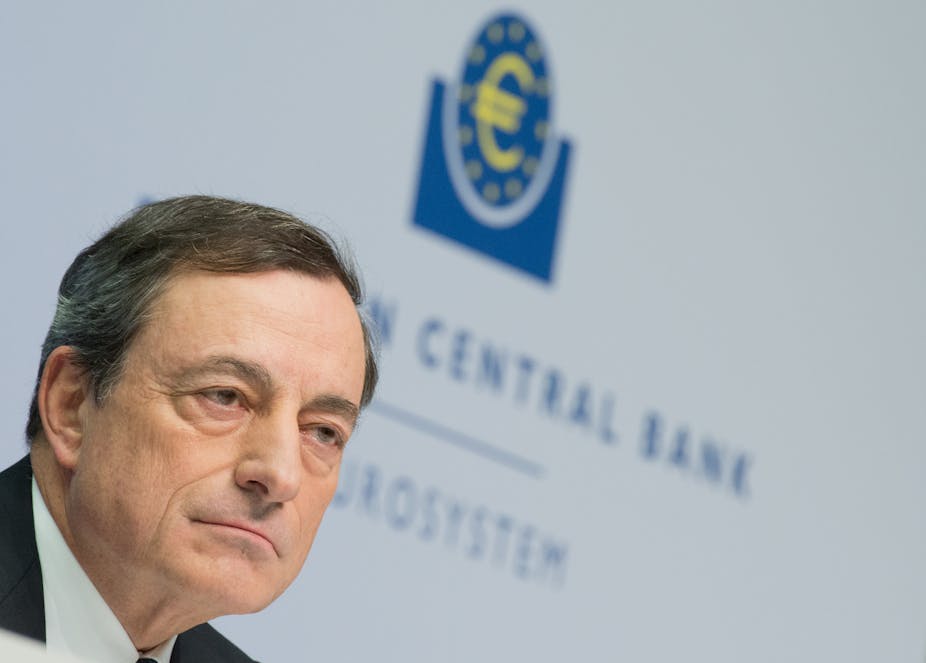As investors anxiously await the announcement from the European Central Bank about whether the eurozone will implement quantitative easing (QE), we can tell from the ECB’s track record that it is very keen to go ahead with it.
Sadly, the ECB’s track record is one of massive boom-bust cycles, banking crises, mass unemployment and general economic pandemonium, following painstakingly in the footsteps of the Bank of Japan and its 30 years of monetary policy terror. QE, in the misguided narrow-track version proposed by the Bank of Japan and advocated by the ECB, of “increased government bond purchases” will fit into that sequence of policy disasters.
From recession to depression
Stepping up bond purchases is likely to ensure that long-term bond yields across the eurozone remain very low, for a long time. With interest rates already at virtually zero, this means the yield curve is being flattened. And a flat yield curve is a disaster for European banks. It will mean they won’t increase lending, ensuring that the European recession turns into a European depression.
By adopting this policy, the ECB may succeed in expanding the size of the economic territory that is blighted by shrinking bank credit growth and rising unemployment. So the ECB expects it may be close to finally achieving its old dream of a eurozone economy humming, or rather stuttering, in synchrony.
Even Germany, whose economy has so far refused to give way to the ECB’s policy onslaught, will be affected by this move. Part of Germany’s best kept secret is its large number of small, local, not-for-profit banks that account for about 70% of all bank deposits in Germany. These are the central reason for the strength and vibrancy of the Mittelstand (the country’s successful small business sector), itself the backbone of the strong German economic performance in the past century.
The ECB expanding
But the ECB has been ever-expanding in its formidable control over banking supervision. This has already begun via the so-called “banking union” control system, and a stepping up of costly regulatory requirements for even the smallest banks. When the new ECB banking supervisors visit a Lower Bavarian bank with eight staff and €50m in assets, the local staff now have to communicate with them in English.
Even more costly is the heavy burden of newly imposed voluminous reports to the supervisors and increased red tape for banks, punishing those that are closest to their local communities. As a result, a new merger wave has been kicked off by EU and ECB regulations among the German local banks. Already, the ECB has overseen the reduction in the number of European banks from more than 10,000 to about 9,000.
If the ECB is set on purchasing long-term government bonds in the eurozone, this will push the yield curve right down towards zero across the entire term spectrum and after five years have crushed local German banks. With such a flat yield curve, banks will be driven out of business and even the surviving ones will reduce their credit creation.
Repackaging an old policy
These bond purchases have been implemented throughout history under an array of different guises – “open market operations”, “reserve expansion” policies or ways to boost “high powered money”, “monetary base”, or “base money”. They are all the same and can also be called monetarist “narrow money” expansion. And it is a policy that is well known not to help in expanding bank credit and so cannot boost nominal GDP growth.
What asset purchases do, however, is increase financial speculation, inflate asset prices and boost profits for the financial elite, thus exacerbating inequality. So of course they are a favourite policy of central banks. To make the policy more acceptable to the public, and less transparent, why not use a new expression – as if there are not yet enough – and ideally one that originally referred to the opposite, namely “quantitative easing”.
When I proposed a policy of “quantitative easing” in Japan in 1995, I pointed out that reserve expansion on its own will not help. What is needed is an expansion in bank credit creation for GDP transactions. This is the true definition of the original QE. Soon after I pointed out that this kind of true QE can easily be achieved by finance ministries stopping issuing government bonds and instead entering into individual loan contracts with the banks in their respective economies. This would actually create a sharp and sustainable recovery and end the eurozone crisis.
Instead the ECB has continued its policy of propagating massive boom-bust cycles, crises and recessions. This is what I warned in 2003, in my book Princes of the Yen, which charts central banking mismanagement of the economy. As I feared, the ECB has stuck to the pre-ordained script previously worked out in Japan. The ECB did so, because it was not modelled on the accountable and highly successful Bundesbank, as has been claimed, but instead is more like a revived Reichsbank, the world’s least accountable, most independent and powerful - as well as the most disastrous central bank. Lord Acton would not be surprised.

